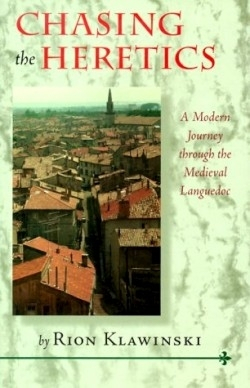Chasing the Heretics
A Modern Journey Through Medieval Languedoc
The heretics in question are the Cathars, a self-contained, anti-clerical sect made up of Believers and Perfecteds. The author is a lapsed Catholic freelance writer deeply interested in them. Believing in a world in which good and evil were a duality, the Cathars were proscribed, slain at sword point, burned alive or otherwise slaughtered during the Albigensian Crusade (1208 - 1229). Though one of the Catholic Church’s bloodiest enterprises, this domestic crusade does not loom large in too many minds today. In relative terms, the players were few, the region small and the duration brief. Yet it is well worth revisiting as it tragically reflects so much of the worst and best in humankind: prohibition of beliefs, relentless suppression, military brutality, heroic resistance, faith unto death, betrayals and massacres. At the close, the infamous Inquisition had been established, a region ravaged and the brilliant Languedocian civilization shattered. As Klawinski perceptively notes, the bloodthirsty and self-aggrandizing mercenary leaders Arnauld Amaury and Simon de Montfort “transformed the Albigensian Crusade from a holy war into a war of territorial conquest.” In political terms, however, this conquest laid the foundations for a unified French nation.
In his engaging memoir of obsession and exploration, Klawinski travels restlessly between the key Cathar cities, switching smoothly from history to digression. Fine-honed descriptions of the massacres at Béziers and Bram, the grandeur of Toulouse’s Place du Capitole, Viollet-le-Duc’s restoration of medieval Carcassone, the austere cathedral of Albi and the siege of Montségur (marking the end of the Cathar community) give way effortlessly to notes on trebuchets, the bridge at Avignon, adventures on the highways and byways of Languedoc and much else of interest.
Klawinski concisely depicts Raymond of Toulouse, his nephew Raymond-Roger of Béziers and Carcassone and Raymond-Roger of Foix, the leading local pro-Cathar notables, all wed to a losing cause. To this core cast, he adds ambitious popes, wily, papal legates, belligerent bishops, crusader commanders (most notably Simon de Montfort), Capetian kings and others. The cast never overwhelms events and events tie back into landscape, loyalties and a vanished way of life, highlighted through vignettes of people and places from the dusty, sun-drenched towns of Languedoc to the cooler valleys bordering the Pyrenees.
It is commendable that an independent publisher issued this book and regrettable that cost factors precluded a portfolio of photographs. Nevertheless, the reader is richly rewarded by this finely written memoir of events that in their day preoccupied popes and kings. The bibliography points interested readers to Strayer and Sumption, major historians of the Albigensian Crusade.
Reviewed by
Peter Skinner
Disclosure: This article is not an endorsement, but a review. The publisher of this book provided free copies of the book to have their book reviewed by a professional reviewer. No fee was paid by the publisher for this review. Foreword Reviews only recommends books that we love. Foreword Magazine, Inc. is disclosing this in accordance with the Federal Trade Commission’s 16 CFR, Part 255.

